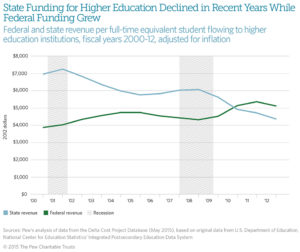Funding sources for U.S. public colleges and universities have turned topsy-turvy over the past decade as states have backed away from their investment in the public good and the federal government has increased it, a new report from the Pew Charitable Trust shows.
Specifically, between 2000 and 2012, state spending on higher education fell 37 percent, while federal dollars increased by 32 percent. But the two kinds of money are not simply interchangeable, and the switch has significant implications for institutions of higher education.
Put simply, state money primarily goes to the colleges — to pay for academic programs and staffing, and other operational expenses. Federal money primarily goes to the student to pay for tuition, often in the form of Pell Grants or government loans. Consequently, the only way that institutions can recoup the loss of state funds is to raise tuition.
And have they ever…Annual tuition at the nation’s four-year public colleges has risen by 28 percent since 2007. (In Arizona, it’s up 80 percent. In Florida and Georgia, 66 percent.) Meanwhile, the nation’s collective student debt now stands at $1.2 trillion, and the federal government has become the nation’s number-one lender for students hoping to mortgage their futures.
 "The decline in state aid and the resulting increase in tuition is the single greatest cause of the explosion in student debt," said NEA higher-ed policy analyst Mark F. Smith. "The increased federal aid only helps to delay the impact on families."
"The decline in state aid and the resulting increase in tuition is the single greatest cause of the explosion in student debt," said NEA higher-ed policy analyst Mark F. Smith. "The increased federal aid only helps to delay the impact on families."
Too many Americans simply can’t afford a higher education, even as a college degree remains their most reliable ticket to the middle class. And they particularly can’t afford to become public school teachers, a profession that has great rewards — but none of them monetary. “Especially now, as the U.S. becomes more diverse, and income inequality grows, we need to make sure all Americans have a fair shot at higher education,” wrote NEA President Lily Eskelsen García recently.
That’s why NEA launched its Degrees Not Debt campaign last year, which, among other things, has called on states to re-invest in higher education and for the federal government to increase Pell Grants and expand loan forgiveness options.
Raising Arizona….
The Pew report makes clear that states have made policy choices — and those choices are reflected in the data. For example, the authors write, “North Carolina’s and Wyoming’s constitutions stipulate that public institutions should be as close to free as possible, and schools in both states receive above-average state revenue and below-average net tuition revenue.”
Meanwhile, in states that have dramatically increased tuition — like Arizona — federal spending per student is far above average. Indeed it is no coincidence that Arizona’s public colleges have both the largest increase in tuition in the U.S. and also the nation’s largest per-student Pell Grant allocation at $3,401, according to the Pew report. (Meanwhile, North Dakota, the state that can boast of the largest increase in state funding over the past year, receives the smallest per-student Pell Grant allocation: $1,177.)
It’s simply a matter of prioritization: Ten states actually have increased spending on public higher education by at least 10 percent over the past year, according to the Center on Budget and Policy Priorities. In Massachusetts, an energetic coalition of students, and NEA-affiliated faculty and staff, brought together by the Public Education Network of Massachusetts (PHENOM) helped win a $100 million boost in funding.
And the federal government can help make it happen, said F. King Alexander, president and chancellor of Louisiana State University, who testified last week during a Senate Health, Education, Labor and Pension (HELP) Committee hearing. “Nobody expected states to get of out the higher ed business,” King lamented. But Senators could help reverse that trend by rewarding states that invest in higher education, he suggested. And those rewards could be part of the pending reauthorization of the Higher Education Act.
Something has to be done, Senators agreed. Pell Grants pay for less than one-third of the cost of college per student, down from two-thirds 20 years ago, noted Sen. Michael Bennet, D-Colo. “College attainment is increasingly inequitable,” said Bennet. If things don’t change, “we’re not going to have a rising middle class in this country!”








